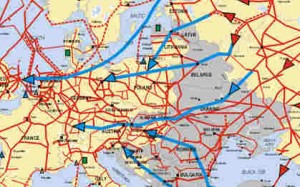 At long last, “power to gas” is recognized among politicians, too.
At long last, “power to gas” is recognized among politicians, too.
Basically, here is what it means: using wind energy, water is separated into H2 and O2 through electrolysis. Being a very tiny molecule, H2 is hard to store. Still it could already be used for energy transport, because the gas pipelines are allowed to hold a H2 rate of 5%. After a possible methanation, it will be identical with natural gas, anyway.
What are the advantages?
The natural gas industry is quite capable of solving its storage problems.
There are pressure storages and caverns which, allegely, can store the demand of two months (200 TWh). It is a realistic option that can be immediately realized without destroying nature. All we have to do is build storage lakes.
Besides, there is the advantage of increasing Germany’s energy transport capacity by 80 per cent through the already existing gas pipelines instantly, without having to build a single new energy line.
Another potential positive aspect is the methanation of H2 gas through CO2 or CO, which might again serve to economize matters. The process will produce “bio-gas”, i.e. reactively produced methane which, when burned, will return the CO2 to the atmosphere “in a CO2 neutral manner” (I put the “quotes” because this is just a modern euphemism).
The enormous advantage of methanation is that the entire transportation could be based on the already working technology of natural gas cars or fuel cells. The car production problem for electric vehicles, the unmentionable and really disgracefully huge ecological footprint of battery technology would be solved. And as a potential energy source for electric vehicles, we might take the fuel cells worked by bio-gas.
A crucial argument in favour of this concept is also that the energy content of 1 kg battery is only 2% of that produced by 1 kg of natural gas. The very weight of batteries threatens to eat up all the technological advance made by light-weight technology.
So here is my point of view in a nutshell: what really gives me pause is that they say we cannot afford a change in energy politics. Currently, the European nations eat the capital they have saved up for breakfast by “rescuing Greece”. At the same time, they forget that there are far more urgent problems that need solving and that you certainly cannot finance both of them simultaneously.
At this very moment, the target demands of the Bundesbank against the EZB are higher than the entire external German capital. According to Prof. Sinn, these are payment requests that “can never be called in” (as he said in the Augsburg IHK Konjunkturgespräch). And then there will be an additional 300 billion Euros for the change in energy policy. Dear China, can you, please, help the poor Europeans.
It is high time that we use the calculator for planning the change in energy policy, instead of the subsidy cart! I believe power to gas might be a really good option.
wl
